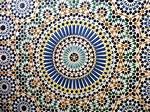In a recent lecture we explored the concepts of Mathematics in relation to aspects of ancient art and how these can be taught with cross curricular intent. Symmetry and pattern are an example of key mathematical concepts which can be explored using art from around the world.

Islamic art uses fantastic pattern and repetition, creating fascinating and eye catching designs used in architecture, religion and clothing to name but a few. Using shapes and folding techniques we explored the possibilities for classroom learning. Shape, position and movement are concepts which can be addressed as early as nursery learning.
Repeating patterns can create dramatic displays for the children to appreciate and encourage their learning, and demonstrate appreciation for their involvement. It is important to be aware of the difficulties some children may face when creating pattern and using tools such as scissors or coloured pattern. Some examples of this can be physical and visual impairments, concentration and proportional and spatial awareness. Creating achievable, differentiated outcomes for children is key to their attainment and this can supported by allowing the children to create their own success criteria.



